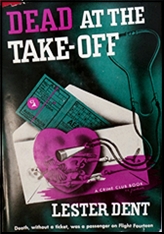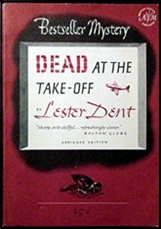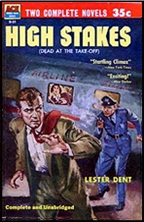Thu 11 May 2023
A 1001 Midnights Review: LESTER DENT – Dead at the Take-Off.
Posted by Steve under 1001 Midnights , Reviews[3] Comments
by Bill Pronzini

LESTER DENT – Dead at the Take-Off. Doubleday Crime Club, hardcover, 1946. Bestseller Mystery, digest-sized paperback, date? Reprinted as High Stakes (Ace Double D-21, paperback, 1953).
Lester Dent is best known as the creator of Doc Savage, the Man of Bronze, who ranks with the Shadow as the most popular cull hero to come out of the pulp magazines of the 1930s. As “Kenneth Robeson,” Dent wrote close to 200 full-length Doc Savage novels for Doc’s own monthly magazine from 1933 to 1949.
Dozens of these have been reprinted in paperback since 1964, under their original titles — Brand of the Werewolf, The Squeaking Goblins, The Living Fire Menace, etc. Despite hokey plots, stereotypical villains, and hurried writing, they contain some ingenious ideas and extrapolations. Dent was much more than a pulp hack; he had genuine talent and a convincing prose style that, when he took the time to polish it, matches up well with the best crime writers past and present.

Dent’s best work is a pair of novelettes featuring detective Oscar Sail, which he wrote for Black Mask in the mid-Thirties, and Dead at the Take-Off, his first novel to appear under his own name. Take-Off is an evocative work, with postwar commercial aviation as its background.
The protagonist is Chance Molloy, the owner of a small airline, AEA, who is facing financial ruin because a conspiracy headed by corrupt Senator Lord has prevented him from buying surplus military transport planes. Molloy, with the aid of two of his staff, has been trying lo obtain proof of the senator’s duplicity, and now believes he has found it.
Lord’s nephew has agreed to turn over damning evidence against his uncle at the senator’s New Mexico ranch. Along with several other principal characters, including the senator’s daughter, Janet, Molloy boards Flight 14 for New Mexico. En route, there is considerable intrigue, capped off when the nephew turns up dead and Janet is drugged. Later, in New Mexico, an attempt is made on Molloy’s life, and the suspense continues to heighten. The violent climax takes place back on board the airliner.

There is plenty of action, but Dead at the Take-Off has much more than that to recommend it. The characterization is sharp, with strong psychological overtones; effective use of flashback is made; and the writing is among Dent’s best. The book is jam-packed with such imagery as:
The ground haze had a faint gun-metal bluish cast, not entirely transparent, but semi-transparent, like tobacco smoke after it has been blown into a bottle.
The book has its flaws — Dent was never able to totally overcome his. pulp origins and there is a good deal of melodrama here — but it is still a very good example of the mid-Forties hard-boiled crime novel.
Dent’s other books are somewhat less successful, although Lady to Kill (1946), which also features Chance Molloy, and the paperback original Cry at Dusk (1952) have many of the same positive qualities as Dead at the Take-Off .
———
Reprinted with permission from 1001 Midnights, edited by Bill Pronzini & Marcia Muller and published by The Battered Silicon Dispatch Box, 2007. Copyright © 1986, 2007 by the Pronzini-Muller Family Trust.
May 12th, 2023 at 8:26 am
I’ve read many Lester Dent books and although they vary in quality, most of them compel the reader to keep turning the pages. As Pronzini points out, Dent’s pulp origins and melodrama affect many of his novels. But I have found them to be quick, entertaining reads.
May 12th, 2023 at 9:49 am
For my money the two Oscar Sail stories are as good as Hammett, Paul Cain and Whitfield. So, needless to say, Dead at the Take-Off just sold another copy.
May 12th, 2023 at 4:59 pm
I enjoyed both of the Chance Molloy novels. Aside from the entertainment and quality of the writing I love mysteries in a closed moving setting like a train, plane, or ship.
I don’t know that other than the two Sail stories Dent ever showed the discipline needed to write successfully on a full time basis in the mainstream mystery field, but the books mentioned by Bill in the review are all very good, and I enjoyed Dent’s shorts about Texas based private eye Curt Flagg that mostly ran in SCOTLAND YARD.
Luckily quite a few of his non Savage stories are available and I recommend in addition to these the pulp novellas from ARGOSY, HADES and HOCUS POCUS, usually packaged together, that owe something to Philip Wylie (no shock as Doc Savage was borrowed from Wylie’s SAVAGE GENTLEMAN) in a good way.
There is a feeling it is hard to escape reading these late Dent mysteries that if he had graduated to the field a decade earlier we might have really had something.